Numerical Simulation and Experimental Measurements of Dynamic Responses of Asphalt Pavement in Dry and Saturated Conditions under Full-Scale Accelerated Loading
Abstract
:1. Introduction
2. Numerical Simulation
2.1. Theoretical Foundation
2.2. Finite Element Model
2.3. Vehicle Loading Model
2.4. Evaluation Indicators
3. Full-Scale Accelerated Loading Test
4. Results and Discussions
4.1. Characteristics of Time–History Curves by FEM Analysis
4.2. Variation Trends of Dynamic Responses with Vehicle Speed and Load by FEM Analysis
4.3. Validation of FEM Model Using Field Measurements
4.3.1. Comparison of Magnitude of Dynamic Responses Based on Same Settings
4.3.2. Comparison of Dynamic Response Magnitude at Different Vehicle Speeds and Loads
4.4. Spatial Distribution of Dynamic Response Indicators by FEM Analysis
4.4.1. Vertical Distribution
4.4.2. Transverse Distribution
5. Conclusions
- (a)
- Trends of modeling results were consistent with those of field measurements.
- (b)
- The increase in vehicle load enhanced dynamic responses. With the increase in vehicle speed, pore water pressure increased, but vertical stress gradually decreased, while transverse strain decreased in dry conditions but slowly increased in saturated conditions in the middle and lower layers. Vertical strain showed different increasing and decreasing trends in the asphalt pavement at different depths.
- (c)
- Dynamic responses decreased with pavement depths. Water made dynamic responses more complex, and pore water pressure significantly decreased with depths within the upper layer of saturated asphalt pavement.
- (d)
- Transverse distributions of indicators presented obvious compressive states in the regions in direct contact with the vehicle wheels, while tensile states were found in the range of the middle vehicle axle.
- (e)
- The numerical results provided a basis for field measurements in future studies, especially for the exploration of factors of temperature and layer depth.
Author Contributions
Funding
Institutional Review Board Statement
Informed Consent Statement
Data Availability Statement
Conflicts of Interest
References
- Wang, W.; Wang, L.; Xiong, H.; Luo, R. A review and perspective for research on moisture damage in asphalt pavement induced by dynamic pore water pressure. Constr. Build. Mater. 2019, 204, 631–642. [Google Scholar] [CrossRef]
- Lu, G.; Liu, P.; Torzs, T.; Wang, D.; Grabe, J. Numerical analysis for the influence of saturation on the base course of permeable pavement with a novel polyurethane binder. Constr. Build. Mater. 2020, 240, 117930. [Google Scholar] [CrossRef]
- Caro, S.; Castillo, D.; Masad, E. Incorporating the heterogeneity of asphalt mixtures in flexible pavements subjected to moisture diffusion. Int. J. Pavement Eng. 2015, 16, 432–444. [Google Scholar] [CrossRef]
- Saad, B. Analysis of excess water impact on the structural performance of flexible pavements. Int. J. Pavement Eng. 2014, 15, 409–426. [Google Scholar] [CrossRef]
- Sun, Y.; Guo, R.; Gao, L.; Wang, J.; Wang, X.; Yuan, X. Study on dynamic response characteristics of saturated asphalt pavement under multi-field coupling. Materials 2019, 12, 959. [Google Scholar] [CrossRef] [Green Version]
- Peng, Y.; Xia, S.; Xu, Y.; Lu, X.; Li, Y. Mechanical response of asphalt surfaces under moving traffic loads using 3D discrete element method. J. Transp. Eng. Part B Pavements 2022, 148, 04022006. [Google Scholar] [CrossRef]
- Dong, Z.; Tan, Y.; Cao, L.; Zhong, Y. Research on pore pressure within asphalt pavement under the coupled moisture-loading action. J. Harbin Inst. Technol. 2007, 39, 1614–1617. [Google Scholar]
- Sheng, Y.; Chen, S.; Wang, D.; Wang, L. Pore water pressure characteristics of semi-rigid base for cement concrete pavement. J. Traffic Transp. Eng. 2012, 12, 6–12. [Google Scholar]
- Sun, Y.; Guo, R.; Wang, X.; Ning, X. Dynamic response characteristics of permeable asphalt pavement based on unsaturated seepage. Int. J. Transp. Sci. Technol. 2019, 8, 403–417. [Google Scholar] [CrossRef]
- Xue, Q.; Liu, L. Hydraulic-stress coupling effects on dynamic behavior of asphalt pavement structure material. Constr. Build. Mater. 2013, 43, 31–36. [Google Scholar] [CrossRef]
- Assogba, O.; Tan, Y.; Zhous, X.; Zhang, C.; Anato, J. Numerical investigation of the mechanical response of semi-rigid base asphalt pavement under traffic load and nonlinear temperature gradient effect. Constr. Build. Mater. 2020, 235, 117406. [Google Scholar] [CrossRef]
- Si, C.; Chen, E.; You, Z.; Zhang, R.; Qiao, P.; Feng, Y. Dynamic response of temperature-seepage-stress coupling in asphalt pavement. Constr. Build. Mater. 2019, 211, 824–836. [Google Scholar] [CrossRef]
- Tang, W.; Ou, J.; Cui, X.; Lou, J.; Xiao, M.; Zhang, J.; Huang, D.; Hou, F. Field test and research on vehicle load induced dynamic pore pressure in asphalt pavement. J. Shandong Univ. 2015, 45, 84–90. [Google Scholar]
- Ling, J.; Wei, F.; Zhao, H.; Tian, Y.; Han, B.; Chen, Z. Analysis of airfield composite pavement responses using full-scale accelerated pavement testing and finite element method. Constr. Build. Mater. 2019, 212, 596–606. [Google Scholar] [CrossRef]
- Yang, Z.; Wang, L.; Xu, B.; Li, S.; Cao, D.; Yuan, B.; Dong, R. Study of the durability of a fully permeable asphalt pavement structure based on the accelerated pavement test method under saturated conditions. J. Transp. Eng. Part B Pavements 2022, 148, 04021081. [Google Scholar] [CrossRef]
- Wang, L. Mechanics of Asphalt: Microstructure and Micromechanics; McGraw-Hill: New York, NY, USA, 2011; pp. 448–450. ISBN 978-0-07-164097-8. [Google Scholar]
- Dong, Z.; Tan, Y.; Cao, L. The effect of water on pavement response based on 3D FEM simulation and experiment evaluation. Symposium on Pavement Mechanics and Materials. In Proceedings of the 18th ASCE Engineering Mechanics Division Conference 2007, Blacksburg, VA, USA, 3–6 June 2007; pp. 34–44. [Google Scholar]
- Li, H.; Sheng, Y. Study on vehicle speed in pore water pressure of rigid pavement base using pore-elasticity. Appl. Mech. Mater. 2012, 178–181, 2615–2618. [Google Scholar] [CrossRef]
- Dong, Z.; Tan, Y. Dynamic Response of Asphalt Pavement; Science Press: Beijing, China, 2015; pp. 188–194. ISBN 978-7-03-041294-2. [Google Scholar]
- Dan, H.; He, L.; Zhao, L.; Chen, J. Coupled hydro-mechanical response of saturated asphalt pavement under moving traffic load. Int. J. Pavement Eng. 2015, 16, 125–143. [Google Scholar] [CrossRef]
- Cui, X. Mechanics of Pavement (Disease); Science Press: Beijing, China, 2016; pp. 57–60. ISBN 978-7-03-047449-0. [Google Scholar]
- Wang, W.; Zhao, K.; Li, J.; Luo, R.; Wang, L. Characterization of dynamic response of asphalt pavement in dry and saturated conditions using the full-scale accelerated loading test. Constr. Build. Mater. 2021, 312, 125355. [Google Scholar] [CrossRef]
- Li, L.; Zhang, Z.; Wang, Z.; Wu, Y.; Dong, M.; Zhang, Y. Coupled thermo-hydro-mechanical response of saturated asphalt pavement. Constr. Build. Mater. 2020, 283, 122771. [Google Scholar] [CrossRef]
- Kim, J. General viscoelastic solutions for multilayered systems subjected to static and moving loads. J. Mater. Civ. Eng. 2011, 23, 1007–1016. [Google Scholar] [CrossRef]
- Bozkurt, T.S.; Karakaş, A.S. Investigation of asphalt pavement to improve environmental noise and water sustainability. Sustainability 2022, 14, 14901. [Google Scholar] [CrossRef]
- Perez-Acebo, H.; Linares-Unamunzaga, A.; Roji, E.; Gonzala-Orden, H. IRI performance models for flexible pavements in two-lane roads until first maintenance and/or rehabilitation work. Coatings 2020, 10, 97. [Google Scholar] [CrossRef]


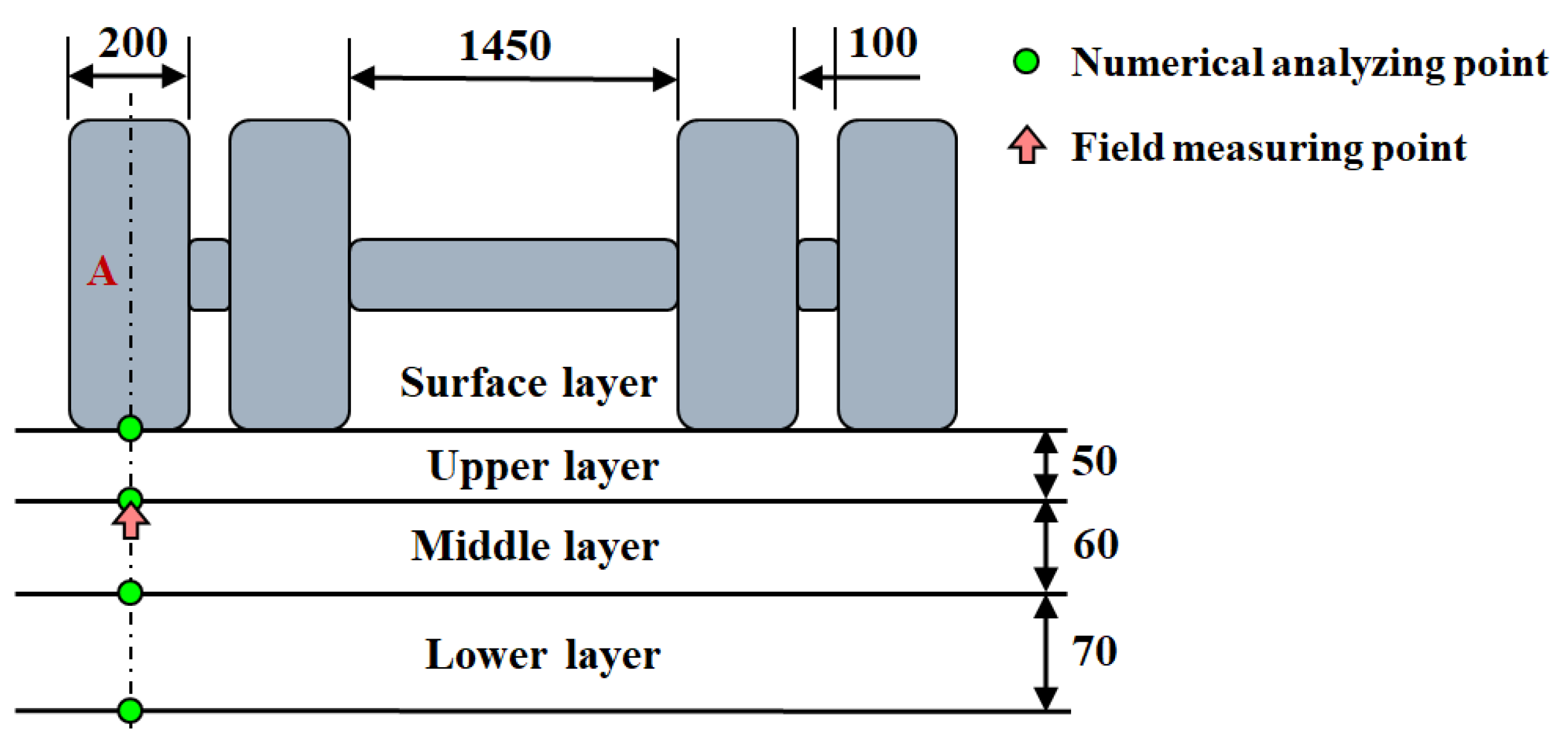

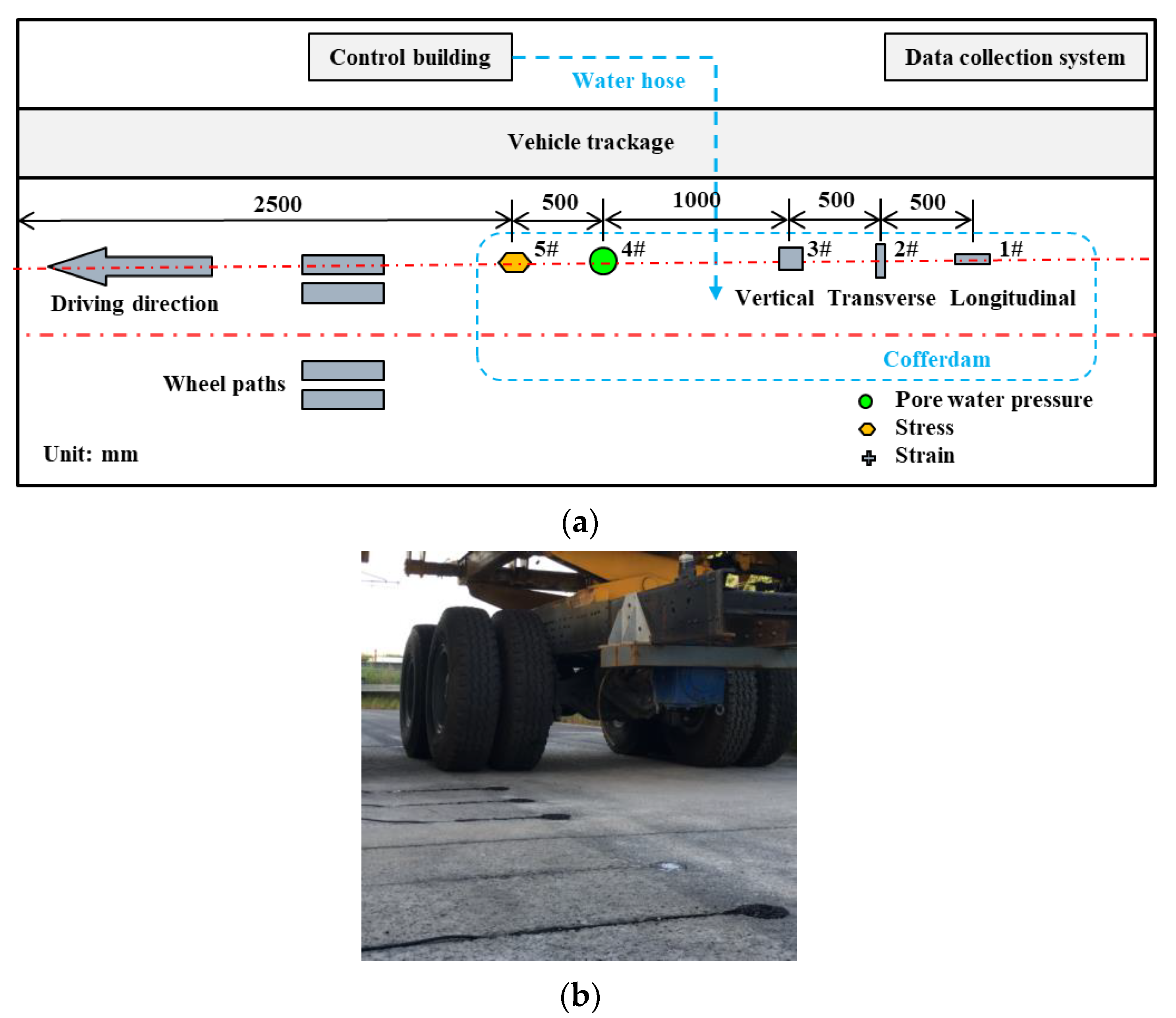
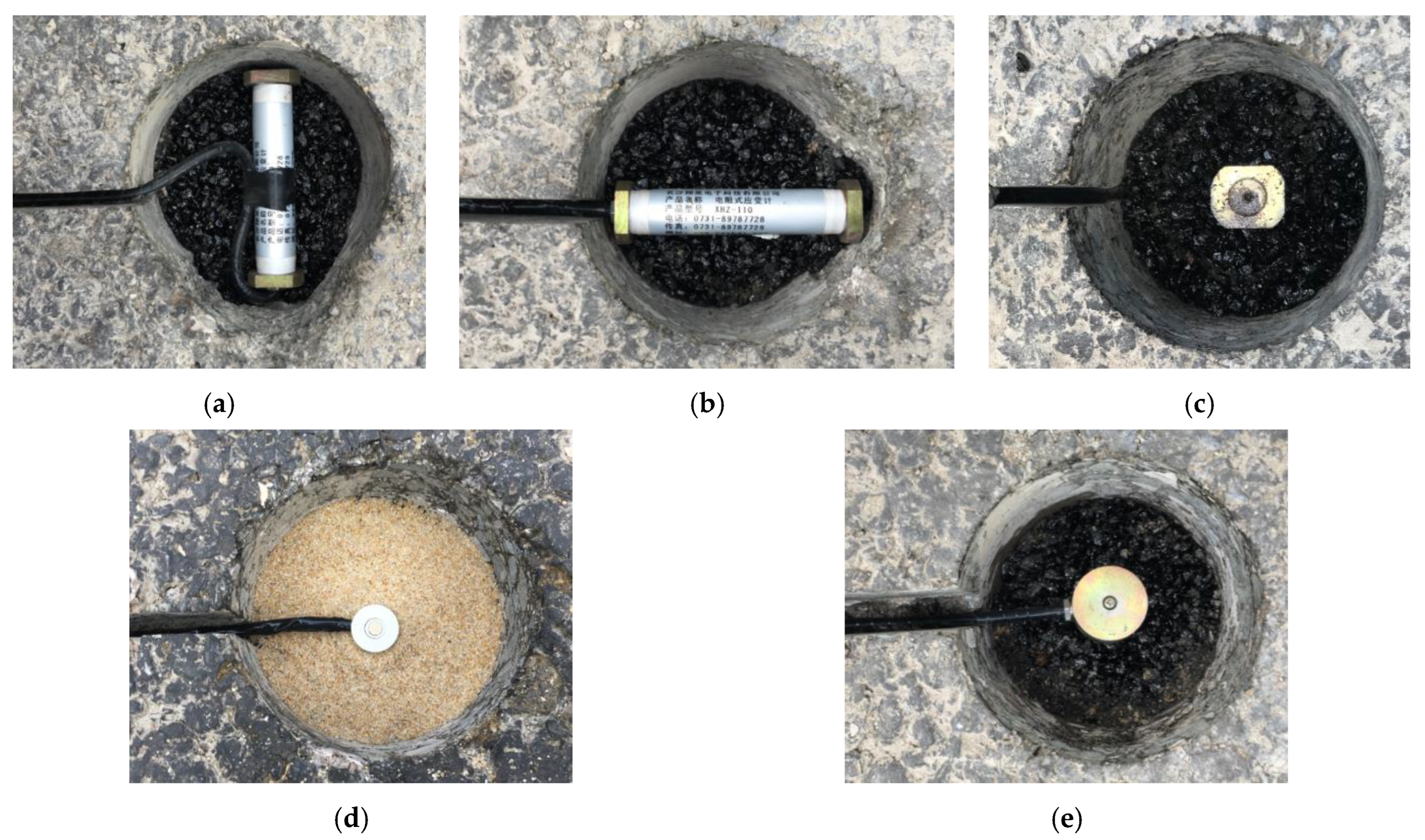

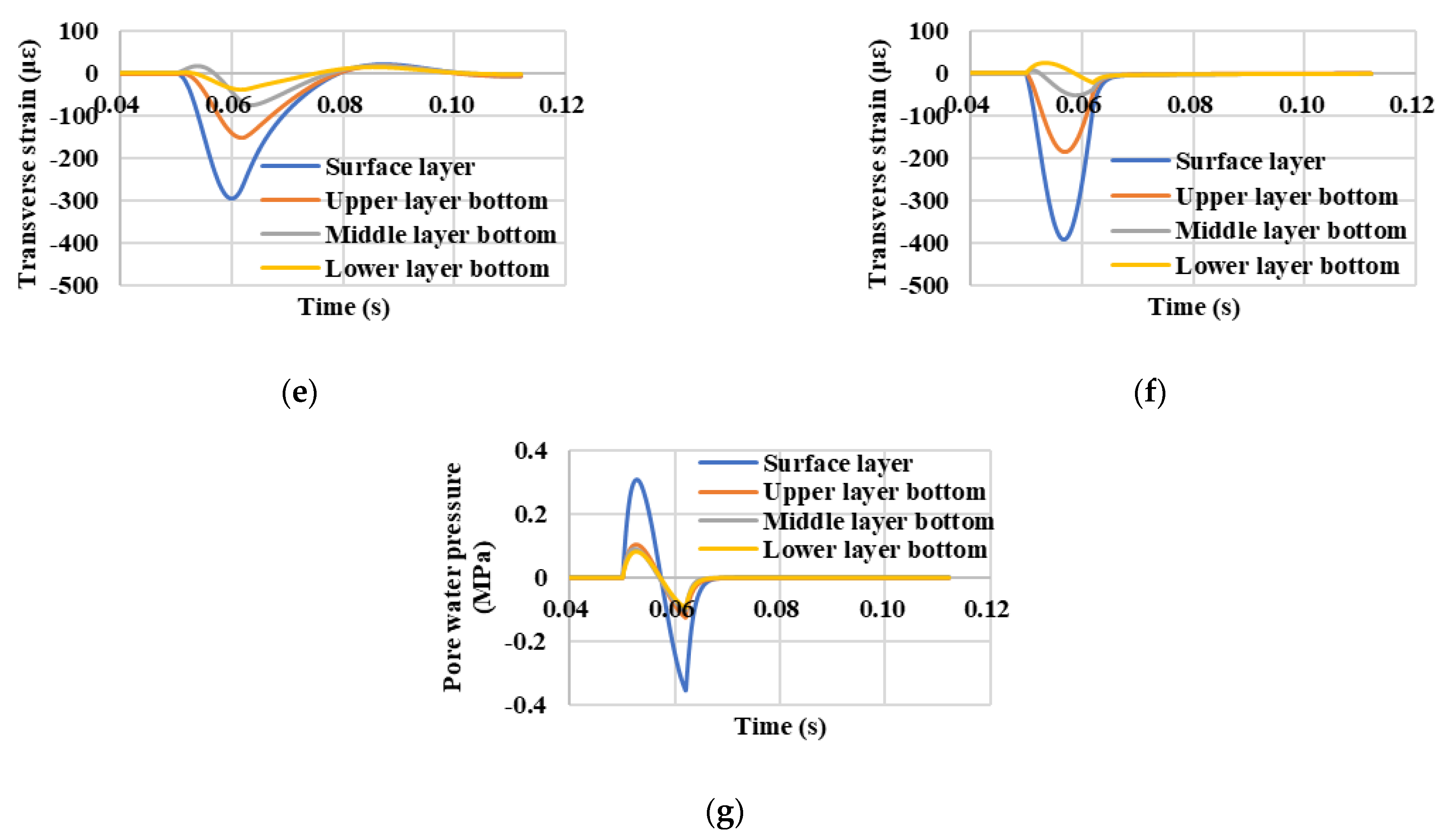

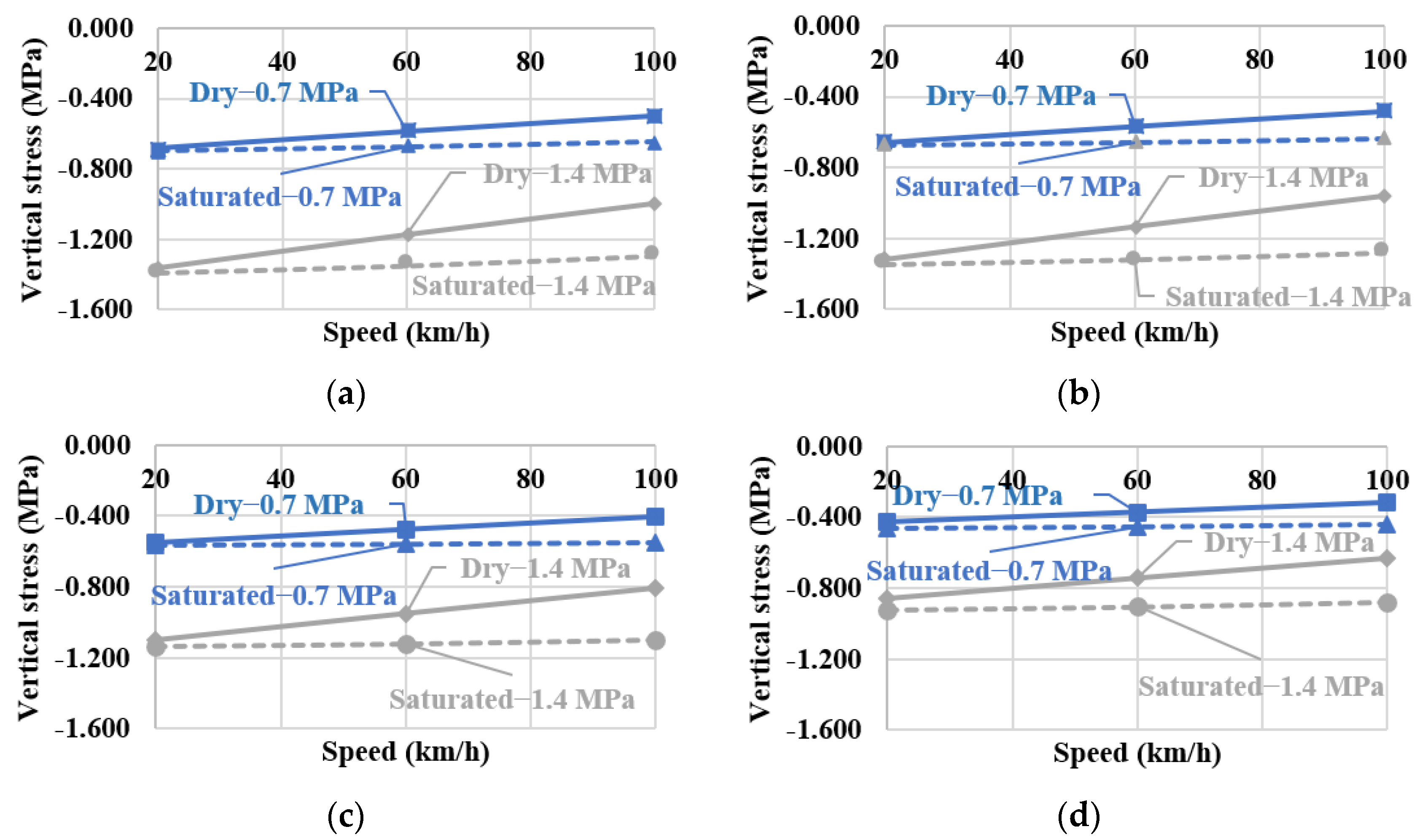
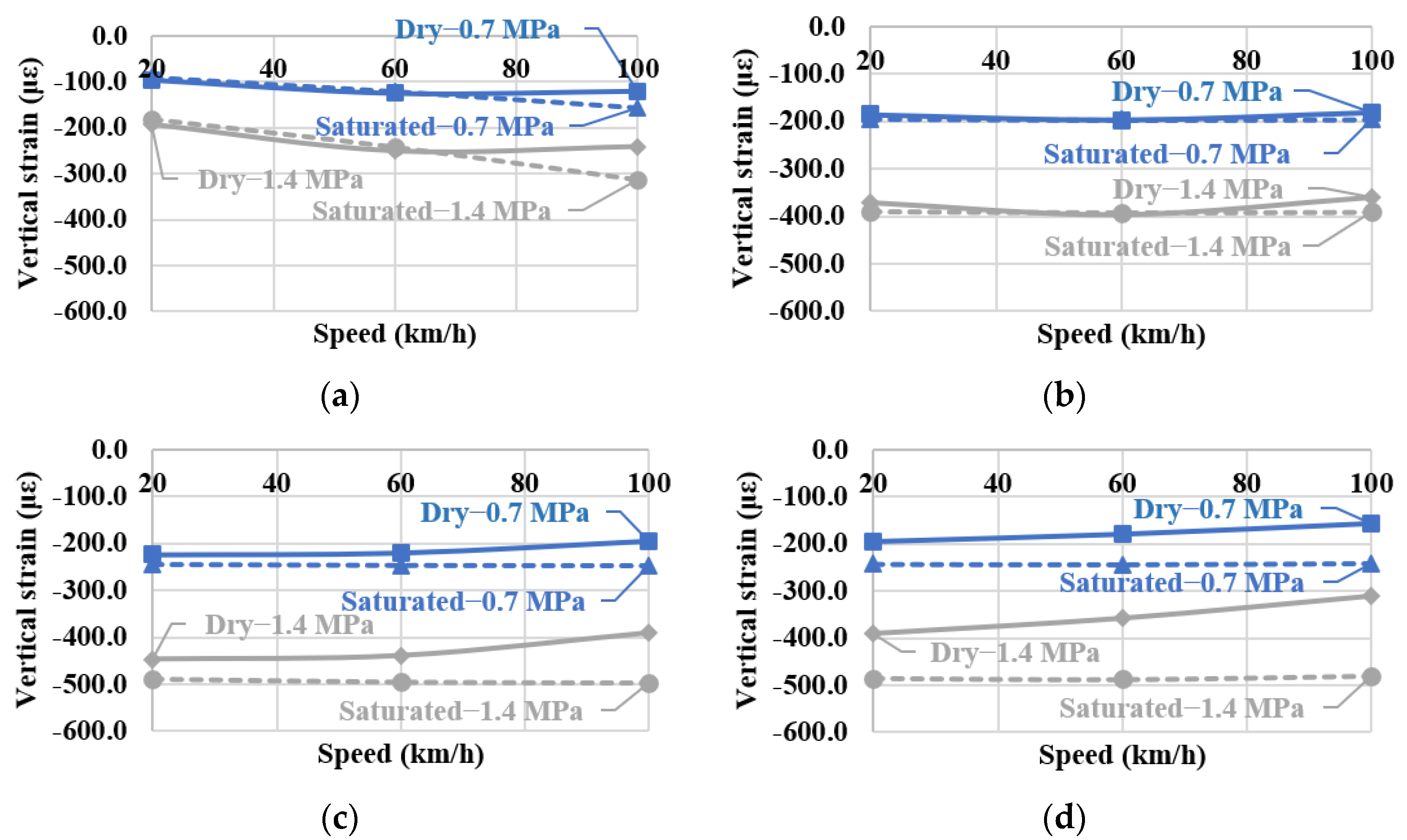





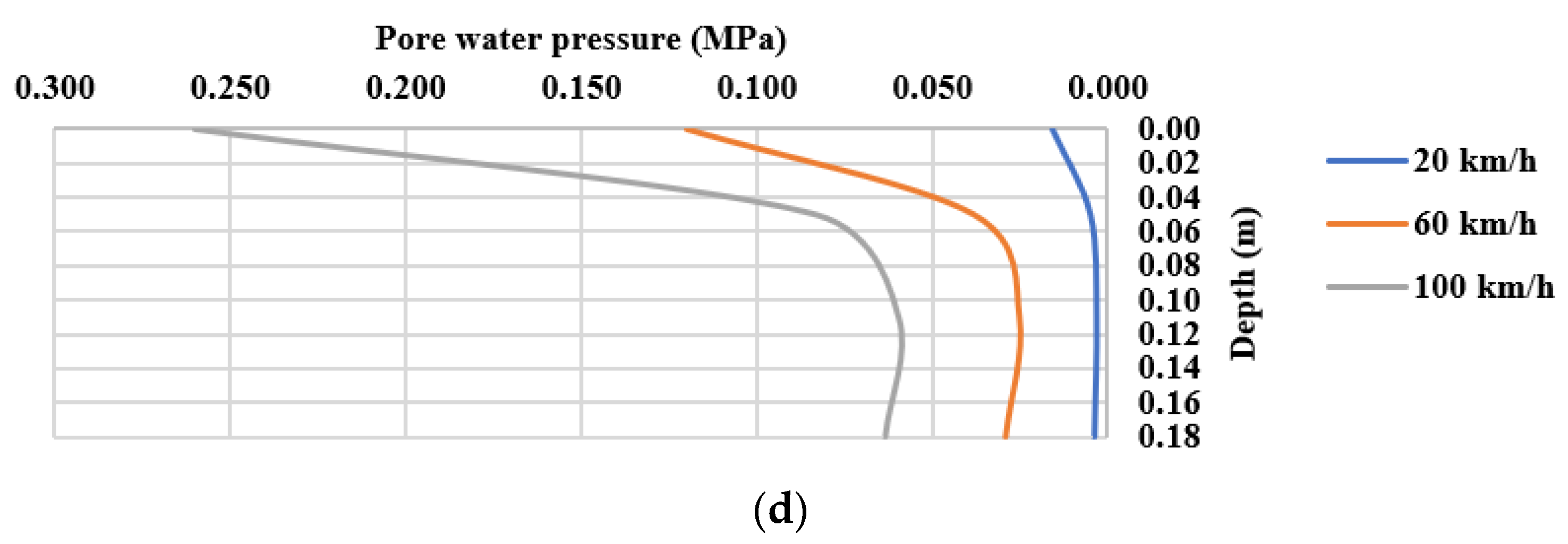
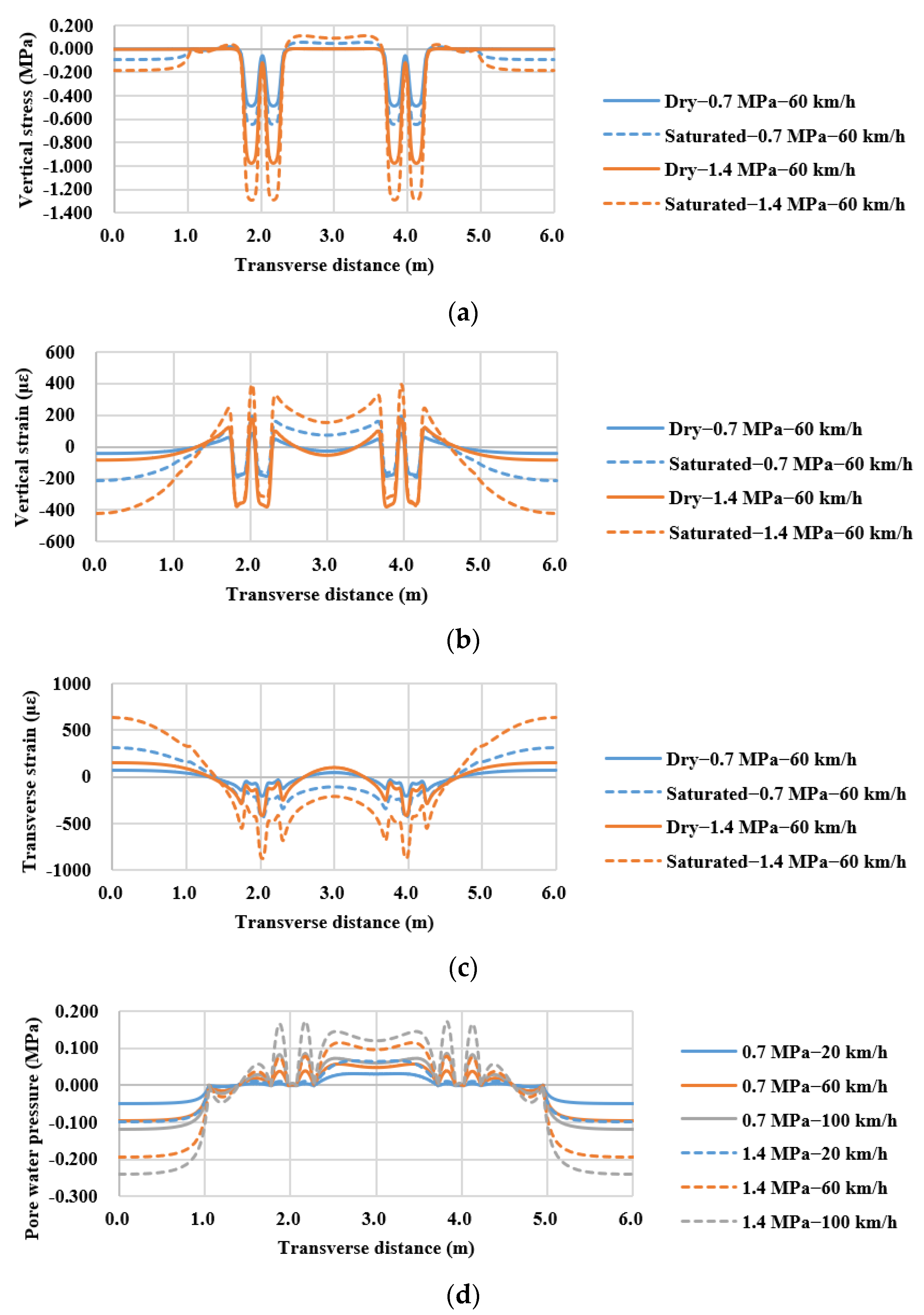
| No. | Structural Layer | Thickness (cm) | Modulus (MPa) | Poisson’s Ratio | Density (kg/m3) | Damping Ratio | Porosity (%) | Permeability (×10–8 m/s) | Water Density (kg/m3) |
|---|---|---|---|---|---|---|---|---|---|
| 1 | Upper SMA-16 | 5 | 1400 | 0.35 | 2400 | 0.05 | 4.0 | 2.13 | 1000 |
| 2 | Middle AC-20 | 6 | 1300 | 0.35 | 2400 | 0.05 | 4.5 | 1.07 | 1000 |
| 3 | Lower AC-25 | 7 | 1200 | 0.35 | 2400 | 0.05 | 5.0 | 1.09 | 1000 |
| 4 | Base | 35 | 1300 | 0.25 | 2100 | 0.05 | 2.0 | 0.1 | 1000 |
| 5 | Subbase | 20 | 600 | 0.3 | 1900 | 0.05 | 3.0 | 0.1 | 1000 |
| 6 | Subgrade | 280 | 50 | 0.4 | 1800 | 0.05 | 4.0 | 0.15 | 1000 |
| Speed (km/h) | Load Duration (s) | Moment Corresponding to Maximum Load (s) |
|---|---|---|
| 20 | 0.036 | 0.068 |
| 60 | 0.012 | 0.056 |
| 100 | 0.0072 | 0.0536 |
| No. | Controlled Parameters | Adjustable Parameters |
|---|---|---|
| 1 | Motor RPM: 580 r/min (Vehicle speed: 20 km/h) | Hydraulic load: 8.5/9.0/9.5/10.0/10.5/11.0/11.5 MPa (Single-wheel grounding pressure: 0.675/0.701/0.728/0.754/0.780/0.807/0.833 MPa) |
| 2 | Hydraulic load: 9.0 MPa (Single-wheel grounding pressure: 0.7 MPa) | Motor RPM: 200/240/280/360/440/540 r/min (Vehicle speed: 6.98/8.42/9.77/12.47/15.07/18.50 km/h) |
| No. | Indicator | Magnitude | ||||
|---|---|---|---|---|---|---|
| Numerical Simulation | Field Test | |||||
| Dry | Saturated | Dry | Saturated | |||
| 1 | Vertical stress | 0.650 MPa | 0.675 MPa | 0.491 MPa | 0.530 MPa | |
| 2 | Vertical strain | 185.6 με | 194.6 με | 353.3 με | 364.7 με | |
| 3 | Transverse strain | 236.9 με | 197.3 με | 135.1 με | 145.6 με | |
| 4 | Positive | Pore water pressure | - | 42.5 kPa | - | 25.29 kPa |
| 5 | Negative | - | 45.4 kPa | - | 7.1 kPa | |
Publisher’s Note: MDPI stays neutral with regard to jurisdictional claims in published maps and institutional affiliations. |
© 2022 by the authors. Licensee MDPI, Basel, Switzerland. This article is an open access article distributed under the terms and conditions of the Creative Commons Attribution (CC BY) license (https://creativecommons.org/licenses/by/4.0/).
Share and Cite
Wang, W.; Yan, G.; Zhao, K.; Wang, L. Numerical Simulation and Experimental Measurements of Dynamic Responses of Asphalt Pavement in Dry and Saturated Conditions under Full-Scale Accelerated Loading. Appl. Sci. 2022, 12, 12291. https://doi.org/10.3390/app122312291
Wang W, Yan G, Zhao K, Wang L. Numerical Simulation and Experimental Measurements of Dynamic Responses of Asphalt Pavement in Dry and Saturated Conditions under Full-Scale Accelerated Loading. Applied Sciences. 2022; 12(23):12291. https://doi.org/10.3390/app122312291
Chicago/Turabian StyleWang, Wentao, Guannan Yan, Kang Zhao, and Linbing Wang. 2022. "Numerical Simulation and Experimental Measurements of Dynamic Responses of Asphalt Pavement in Dry and Saturated Conditions under Full-Scale Accelerated Loading" Applied Sciences 12, no. 23: 12291. https://doi.org/10.3390/app122312291






